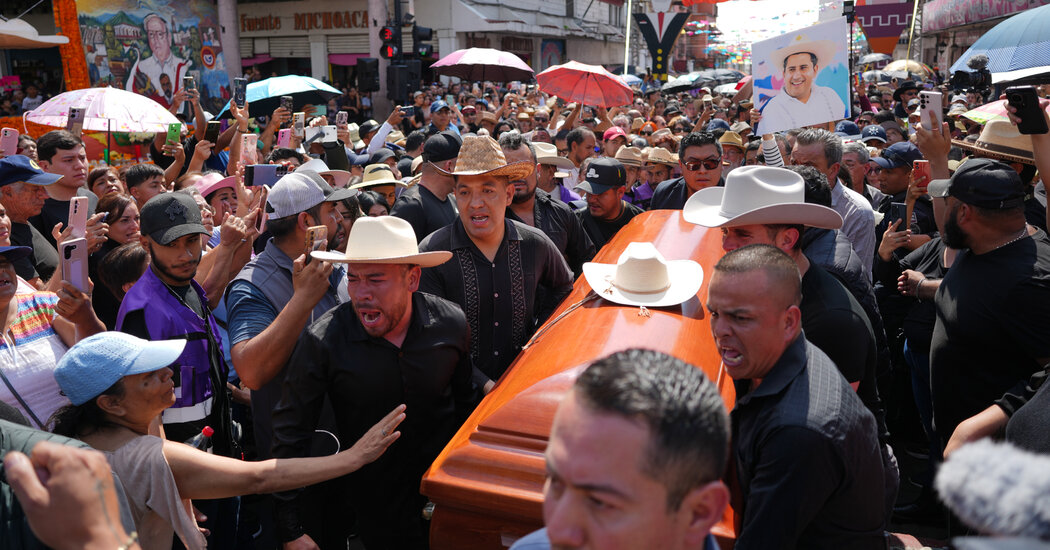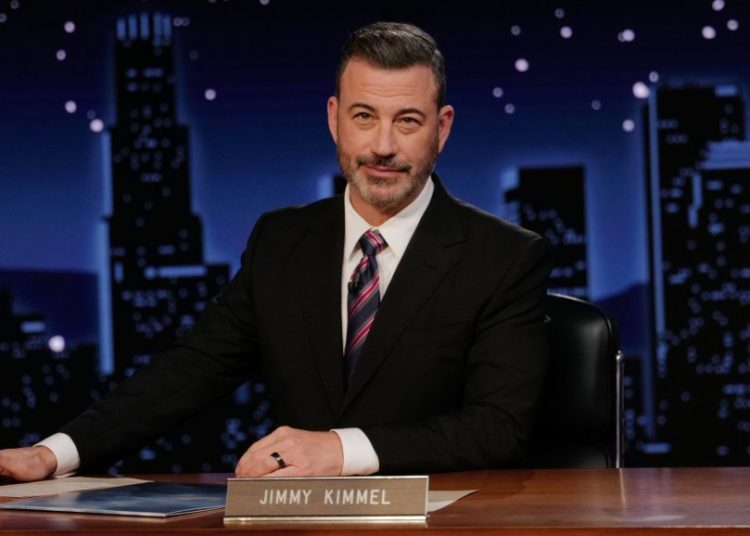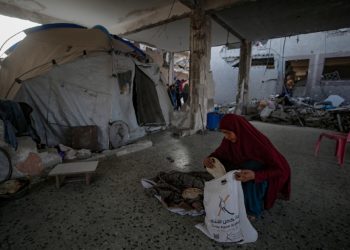Carlos Manzo, a mayor in western Mexico, gained national fame this year with a simple but aggressive demand: that the Mexican authorities should summarily kill the armed cartel members who terrorize the country.
That militant stance made him extremely popular with voters in his city, Uruapan, and beyond. It also led the 40-year-old mayor to start wearing a bulletproof vest with his trademark cowboy hat, and Mexico’s federal government to assign military personnel to protect him.
In June, he recalled receiving a chilling phone call from a man who threatened to kill his toddler son. “I responded as any father would,” he said. “I told them, ‘I’ll be waiting for you.’”
On Saturday night, Mr. Manzo held his son as he gave a speech at a crowded Day of the Dead celebration in his city of 350,000. Moments later, just after Mr. Manzo handed off his child, a hooded gunman shot the mayor seven times, killing him.
Even by Mexico’s standards, it was a strikingly brazen assassination. Given its target and public nature, it also served as a warning shot of sorts for President Claudia Sheinbaum.
Since taking office a year ago, Ms. Sheinbaum has led the most aggressive campaign against Mexico’s cartels in nearly a decade. She has also done so with an almost surgical approach, resisting calls from politicians like Mr. Manzo for another all-out war on drugs, as other Mexican presidents had tried with bloody results.
In her first year, authorities said they arrested nearly 35,000 people for high-impact crimes and destroyed nearly 1,600 drug labs, compared with 8,900 such arrests and 380 destroyed labs annually under her predecessor. In the process, Mexican officials said, homicides have dropped by almost a third, to their lowest level in a decade, and fewer drugs are crossing into the United States.
Those efforts have earned Ms. Sheinbaum praise from the White House and appeared to stave off a U.S. military intervention in Mexico to fight the cartels, at least for now.
Yet the cartels are far from defeated. And in recent months, they have shown repeatedly that they are ready to fight, executing a series of high-profile murders, including Mr. Manzo’s.
In May, gunmen on motorbikes murdered the personal secretary and a top adviser to Mexico City’s mayor while they sat in traffic. On one day in June, 20 bodies were found in the state of Sinaloa, with several decapitated and hanging from a bridge.
In September, two Colombian musicians were kidnapped and killed after their concert in Mexico, prompting outrage from Colombia’s president. And last month, a journalist who reported on cartels in the state of Durango was found dead, wrapped in a blanket.
In the first half of the year, there were 112 political assassinations in Mexico, according to Integralia, a political-risk consulting firm. In the first 10 months of the year, more than 300 police officers were killed, up 24 percent from a year before, according to Common Cause, an anti-corruption group.
“It’s been a reality check,” said Nancy Canjura, a security expert at Common Cause. “While they’re still trying to piece together where the leadership is, who controls whom or where the conflict is, the dead are still there — and they keep adding up.”
Mr. Manzo’s killing, she added, “is the confirmation that criminal groups, not the authorities, control the territory.”
On Monday, Ms. Sheinbaum condemned Mr. Manzo’s killing but rejected changing course. “We will continue working every day for the defense of peace, security and justice,” she told reporters. “That’s the way forward. And we will never, ever, give up.”
Ms. Sheinbaum’s strategy against the cartels has largely focused on capturing leaders and carrying out large drug busts. Some security analysts said that while that has effectively displayed strength to Washington, it has hardly weakened the groups’ stronghold on many local communities.
“Let’s keep our neighbor to the north as happy as possible and show them that we are working,” said Giovana Ríos, who researches Mexico’s violence at the Jesuit University of Guadalajara. “But on the other hand, we find all these town halls co-opted by organized crime or with weakened police forces that don’t have the resources or the means to deal with the situation.”
That local level is the primary battleground where criminal groups exert their power in Mexico, analysts say. It’s the basic administrative unit they must capture to control territory. It’s where they are able to extort businesses and capture public funds. And it’s where they corrupt many officials who either collaborate or stand aside to avoid getting the crossfire.
Michoacán, a state of 4.7 million people, has emerged as one of the most difficult and deadly fronts in that battle. Several cartels are fighting over control of drug-trafficking routes and lucrative extortion rackets there. In Uruapan, Mr. Manzo’s city in Michoacán, criminal groups extort farmers who grow limes and avocados.
The authorities and farmers have tried to fight back, but the cartels have responded violently. Last month, one of Michoacán’s most prominent lime-industry leaders was murdered after he denounced the extortion. On Saturday, hours before Mr. Manzo’s killing, another large lime farmer and his wife were found dead.
That carnage had fueled Mr. Manzo’s hard-line approach.
Over the past year, he encouraged his city’s police to kill armed criminals — a proposal criticized by Ms. Sheinbaum. He said he would reward officers who killed cartel hit men. And this month, he demanded the federal government provide military-grade weapons so his city’s police could match the cartels’ firepower.
“There can’t be hugs for criminals,” he said in May, referring to the “hugs, not bullets” crime strategy of Ms. Sheinbaum’s predecessor and mentor. “For criminals, there must be beat-downs.” He added an expletive.
That rhetoric put him on the national stage and led both critics and supporters to call him the “Mexican Bukele” after President Nayib Bukele of El Salvador, whose violent crackdown on gangs has sent crime plummeting in his country while alarming human rights groups.
It also put him in opposition to Ms. Sheinbaum, who has sought to use intelligence and investigation to target cartels more precisely, a policy she hopes will prevent the mass casualties that were a hallmark of past governments’ wars on the groups.
Ms. Sheinbaum enjoys approval ratings of over 70 percent, yet polls show Mexicans are highly critical of her performance on security, which has long been the country’s most pressing issue. Although the government has released statistics showing Mexico is safer, many Mexicans believe that violence has gotten worse under Ms. Sheinbaum, a recent national survey found.
Since Mr. Manzo’s death, angry citizens in Michoacán have marched in the streets. Many commentators have seized on the assassination to argue that Ms. Sheinbaum’s security strategy is failing.
At two news conferences this week, Ms. Sheinbaum said her government would bring Mr. Manzo’s killers to justice, including those who ordered the murder. The apparent gunman was killed at the scene and two other people have been arrested, the authorities said. The city police had been assigned to protect Mr. Manzo at the event, while members of Mexico’s National Guard were securing the perimeter, they added.
Ms. Sheinbaum said her government would also intensify efforts to combat violence in Michoacán, including by adding more federal forces and inaugurating a specialized prosecutor’s office.
As for her critics who say she is losing to the cartels, Ms. Sheinbaum shot back.
“Of course we’re asking, How do we strengthen our strategy?” she said.
“But, I repeat, what are they proposing? Going back to the war on drugs?” she added. “Mexico already tried that, and it didn’t work.”
Jack Nicas is The Times’s Mexico City bureau chief, leading coverage of Mexico, Central America and the Caribbean.
Emiliano Rodríguez Mega is a reporter and researcher for The Times based in Mexico City, covering Mexico, Central America and the Caribbean.
The post Bold Assassinations Are ‘Reality Check’ in Mexico’s Cartel Fight appeared first on New York Times.




